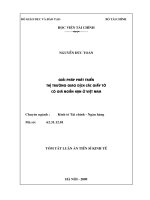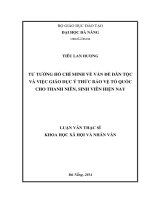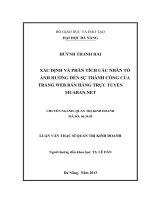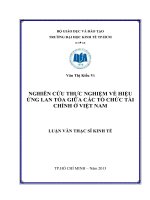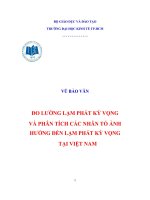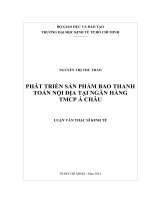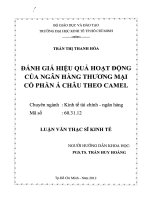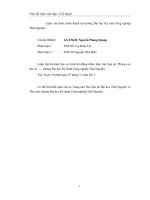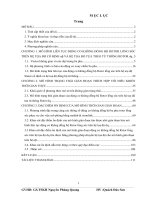(Luận văn thạc sĩ) the impact of tourists’ emotional experiences on their satisfaction and willingness to recommend a case of vietnam
Bạn đang xem bản rút gọn của tài liệu. Xem và tải ngay bản đầy đủ của tài liệu tại đây (1.53 MB, 90 trang )
VIETNAM NATIONAL UNIVERSITY, HANOI
VIETNAM JAPAN UNIVERSITY
PHAN THI THANH TAM
THE IMPACT OF TOURISTS’ EMOTIONAL
EXPERIENCES ON THEIR SATISFACTION
AND WILLINGNESS TO RECOMMEND: A
CASE OF VIETNAM
MASTER THESIS
BUSINESS ADMINISTRATION
Hanoi, 2019
VIETNAM NATIONAL UNIVERSITY, HANOI
VIETNAM JAPAN UNIVERSITY
PHAN THI THANH TAM
THE IMPACT OF TOURISTS’ EMOTIONAL
EXPERIENCES ON THEIR SATISFACTION
AND WILLINGNESS TO RECOMMEND: A
CASE OF VIETNAM
MAJOR: BUSINESS ADMINISTRATION
CODE: 60340102
RESEARCH SUPERVISORS:
ASSOC.PROF. PHAM THI LIEN
PROF.DR. MOTONARI TANABU
Hanoi, 2019
ABSTRACT
Today, globalization as well as the advancement of technology is narrowing the
distances of nations. Increasingly, there are more and more interactions between
nation states and individuals necessitating the need to boost exchange cultures and
tourism. Vietnam has become an attractive destination of tourists due in part to its
charm, natural beauty, as well as its rich history and culture. There is a positive
relationship among the positive emotion, overall image, satisfaction, and both effect
intention to recommend. This study investigates the emotions of joy and love as
significant influences on tourists‟ satisfaction and its effect on intent to recommend
while exploring whether or not the emotion of positive surprise does not support this
relationship. To explain the impact of emotional experience on tourists‟ satisfaction
and willingness to recommend, this study follows revised Destination Emotion Scales
(DES) model of (Hosany,2013; Payage,2017; Sharma,2018). The survey was carried
out with 224 foreign tourists who have travelled to a few famous places in Vietnam at
least one time by both online and offline method. The methodology used in our
research is a quantitative method. SPSS software 20 and AMOS 21 with SEM
(structural equation modelling) to carry out analysing on data gathered through a
survey. The thesis makes a significant contribution to tourism marketing in Vietnam
because some of the empirical findings found in the study deal with aspects of
tourists‟ satisfaction and their willingness to recommend necessary to improve
Vietnamese tourism.
Keywords: tourist satisfaction, tourists‟ emotional experiences, overall
destination image, willingness to recommend.
i
ACKNOWLEDGEMENT
Two years of studying Master‟s program in Vietnam Japan University (“VJU”)
were a precious and unforgettable time of my life. At the moment of the Master course
application, I was working as a senior accountant for Taisei – Vinaconex Joint
Venture, the main Japanese contractor conducted to build Noi Bai Airport
International Terminal 2 in Hanoi. Before making a decision to apply for VJU Master
course, I had spent a lot of time seeking an MBA course which cooperated between
Vietnamese University and the Foreign University. Finally, I decided to choose the
Master program in VJU because VJU is not only appropriate for my career in my
Japanese company but also a dynamic study environment where I would receive the
strongest support from lecturers and VJU staffs and classmates.
I passed four semesters of hard daily struggling with myself but also enjoyed
school life to archive the master degree. The first semester was the time of struggling
with changing my habits and behavior. I had to force myself to be familiar with
academic study after ten years of working engagement without learning the academic
practice. The second semester was the busiest time when the subjects were full
schedule booked, daily classes attended, a bundle of tests and examinations were
delivered. At that moment, I had to arrange my schedule to adapt to both studying and
working. The third semester started with the four-month internship in Japan. During
four months from October 3rd, 2018 until February 2nd, 2019, I did an internship at
Yokohama National University (YNU), one of the most famous historical universities
in the beautiful city of Yokohama in Japan. Throughout the learning activities,
company visits as well as other exchange culture activities, I gained much knowledge
but more importantly, I also had an exciting chance to experience studying in an
international environment where I became acquainted with foreign students from
different countries around the world. It was a great opportunity for me to enhance my
training of communication skills that I practiced through the giving of presentations,
in discussions with my supervisory professors, and working in teams with my
classmates from foreign countries. Moreover, company visits provided me practical
knowledge of many different business fields such as food and beverage, automotive,
ii
cosmetic, logistics, and the airline industry which will be necessary for my career in
the future. The fourth semester was the hardest time when I was struggling with a
thesis to complete my master degree. It was the time of reading academic materials,
taking notes, conducting a survey, collecting and analyzing data, writing thesis little
by little daily.
My master thesis would have never accomplished without the help and support
of the kind people whom I mention below:
First, I would like to thank my parents for their long caring support of love to
me. As well, I would like to express my thanks to my bosses and colleagues in Taisei
– Vinaconex Joint Venture for their support during my job while I pursued my studies.
Especially, I am deeply appreciative to my professor supervisor Assoc.Prof. Pham Thi
Lien for her expert guidance, understanding, and encouragement throughout my study
and research. While starting my research with knowledge gaps but she instructed me
to step by step with care and patience. I also would like to express my gratitude to my
professor supervisor Prof. Tanabu Motonari who inspired the critical ideas and gave
me valuable instruction for completing my thesis successfully.
With regard to my four-month internship in Japan, I must thank Prof. Matsui Yoshiki,
IPO staffs as well as professors and staffs of Yokohama National University who were
always sided by side with me during the time I was there.
My gratitude goes to the entire MBA department of Vietnam Japan University
for arranging the best facilities and schedules for us.
Last but not least, I would like to convey my gratitude to Japan International
Cooperation Agency, Vietnam Japan University, Yokohama National University for
funding and arranging this wonderful MBA Program, which helped me to develop
myself both academically, professionally, and socially.
iii
TABLE OF CONTENTS
ABSTRACT ................................................................................................................... i
TABLE OF CONTENTS ............................................................................................ iv
LIST OF ABBREVIATITION ................................................................................... vi
LIST OF FIGURES .................................................................................................... vii
LIST OF TABLES ...................................................................................................... vii
CHAPTER 1 INTRODUCTION................................................................................. 1
1.1. Research Problem ................................................................................................. 1
1.2. Research Objectives .............................................................................................. 3
1.3. Research Purposes ................................................................................................ 3
1.4. Research Questions ............................................................................................... 3
1.5. The Scope of the Study ......................................................................................... 4
1.6. The Research Design ............................................................................................ 4
1.7. The Structure of the Paper .................................................................................... 4
CHAPTER 2 LITERATURE REVIEW .................................................................... 6
2.1. The Concept of Tourist Satisfaction ..................................................................... 6
2.2. The Definition of Tourists‟ Emotional Experiences ............................................. 9
2.3. The Definition of Overall Destination Image ..................................................... 16
2.4. Conceptual Framework ....................................................................................... 16
2.5. The Relationship Between Emotional Experiences On Overall Image and
Satisfaction ................................................................................................................ 19
2.6. The Relationship Between Satisfaction and Overall Images and Behavioral
Intentions. .................................................................................................................. 20
2.7. The Role of Socio Demographic Variables in Moderating the Relationship
Among Tourists‟ Emotional Experiences, Satisfaction, Overall Image and
Willingness to Recommend. ..................................................................................... 21
CHAPTER 3 HYPOTHESES AND MODELS ....................................................... 22
3.1. Research Process ................................................................................................. 22
3.2. Research Model .................................................................................................. 22
3.3. Research Model .................................................................................................. 23
iv
CHAPTER 4 METHODOLOGY ............................................................................. 32
4.1. Research Method ................................................................................................ 32
4.2. Research Process ................................................................................................. 32
4.3. Measurement Scale ............................................................................................. 33
4.4. Data Analysis Method ........................................................................................ 36
4.5. Sampling and Data Collection ............................................................................ 36
CHAPTER 5 RESULTS AND FINDINGS .............................................................. 38
5.1. Sample Profile..................................................................................................... 38
5.2. Descriptive Statistics and Internal Consistency Reliability Test ........................ 40
5.3. Exploratory Factor Analysis (EFA) .................................................................... 42
5.4. Testing Research Model Using Structural Equation Modelling (“SEM”) ......... 44
5.5. Moderator Analysis............................................................................................. 50
5.6. Hypotheses Results ............................................................................................. 51
CHAPTER 6 DISCUSSION, IMPLICATIONS, ECOMMENDATIONS ............ 53
6.1. Discussion ........................................................................................................... 53
6.2. Limitation and Recommendation........................................................................ 54
6.3. Conclusion .......................................................................................................... 56
REFERENCES ........................................................................................................... 57
APPENDIX.................................................................................................................. 72
v
LIST OF ABBREVIATITION
CFA: confirmatory factor analysis
EFA: Exploratory factor analysis
SEM: Structural Equation Modeling
MLE: Maximum Likelihood Estimation
CR: Composite Reliability
AVE: Average Variance Extracted
DES: Destination Emotion Scales
FDI: Foreign Direct Investment
GDP: Gross Domestic Product
vi
LIST OF FIGURES
Figure 2.1 The Wheel of Emotion ................................................................................ 11
Figure 3.1 Research Process ......................................................................................... 22
Figure 3.2 Research Model ........................................................................................... 23
Figure 5.1: Confirmatory Factor Analysis (CFA) ........................................................ 45
Figure 5.2: Structural Equation Modeling .................................................................... 48
LIST OF TABLES
Table 2.1: Destination image definitions...................................................................... 16
Table 4.1: Measurement scales ..................................................................................... 34
Table 5.1: Sample profile ............................................................................................. 39
Table 5.2: Descriptive statistics and reliability test ...................................................... 40
Table 5.3: Pattern Matrixa ............................................................................................ 42
Table 5.4: Total Variance Explained ............................................................................ 43
Table 5.5: Fit indices for the test model result (CFA) .................................................. 46
Table 5.6: Measurement model .................................................................................... 47
Table 5.7: Regression weights ...................................................................................... 49
Table 5.8: Results of Hypotheses ................................................................................. 51
vii
CHAPTER 1
1.1.
INTRODUCTION
Research Problem
According to the report “Travel & Tourism Economic impact 2018, South
East Asia” issued by The World Travel & Tourism Council (WTTC, 2018), the
contribution of tourism in GDP in 2017 is 329.5 billion USD and accounts for 12%
of the total grand GDP and is estimated to continue to increase up to 598.3 billion
USD in 2028 (estimated for 13% of total GDP) (WTTC, 2018). This rate points out
the important role of tourism in economic development currently. Therefore, South
East Asia would be well served to develop tourism as an economic incentive.
Moreover, the impact of globalization and economic trends towards emergent
Southeast Asia economies currently increased tourism demand in this area
dramatically, thus bringing big potential in economic development. In 2017, Asia
and Pacific accounts for 30% of world international tourism receipts (UNWTO,
2017). Following these trends, Vietnam is also becoming an attractive destination
for tourists. In 2017, Vietnam welcomed 12.9 million international tourists, which
offered a gain of 541 billion VND of income and directly contributed 7.9% of GDP
(VNAT, 2017).
To boost tourism development, the Vietnamese government has launched
many activities such as issuing tourism legal documents, organized events, and
festivals, improving public transportation and tourism facilities. Also, tourism
research has recently developed tourism reports which are published frequently and
provide statistics. Through the awareness of the important role of marketing in
tourism, tourism marketing strategies are also focused on promoting Vietnam as a
destination image to the world through advertising actives, exhibitions, and
international cooperation. Tourist marketing researchers trying to find better
solutions for Vietnam marketing tourism are concentrated on 1) evaluating the
tourist satisfaction at destinations (Thuy, 2006; Giang, 2013); 2) the impact of
destination on loyalty (Huong, 2015); and 3) tourism service quality to behaviour
1
intention (Hai, 2015). However, there are only a few journal articles that mention
tourists‟ emotional experiences within Vietnam tourism marketing market.
From a tourist marketing perspective, the role of tourists‟ emotional
responses has been acknowledged as a useful factor when applied to tourism
marketing strategies. Therefore, some countries are using emotional tourism slogans
to attract more tourists because they think that emotions will impact tourist‟s
expectation on vacation destination (Nuria, 2017). For example, India “Incredible
India”, Thailand “Amazing Thailand”, Indonesia “Wonderful Indonesia”, the
Philippines “It is more fun in Philippines”, Brazil “Sensational Brazil” (Nuria,
2017). Nevertheless, studying tourists‟ emotions are problematic because human
emotions are complicated and difficult to measure. Especially the study of tourists‟
emotional experiences of overall image, satisfaction, and willingness to recommend
is more complicated because there is no official standardization to measure the level
of emotional effect of all these factors and the linkage between them are under
study. In the research series of Prayag and Hosany and their collaborators, they
discovered that positive emotions have an effect on the overall image, satisfaction,
and both effect intention to recommend (Hosany, 2010; Hosany and Prayag, 2013).
These results and their Destination Emotion Scales (DES) conceptual modes are
quite recent and more research using this theoretical model is warranted. This study
will be utilizing the revised DES model, a model that has as yet only been used a
few times (Payage,2017; Sharma,2018). None thus far have studied the variables in
my research, which considers the context of Vietnam as impacted by demographic
moderators such as cultural background, prior experience, age, gender, and type of
tour. Furthermore, this research aims to examine the new conceptual model of
emotion and satisfaction developed by Payage.G and his collaborators in 2017 in
other different contexts in order to provide empirical evidence test for a boarder
appropriate model. In addition, outcomes of this project have the potential to raise
awareness of the role of tourists‟ emotional experiences in Vietnam tourism
marketing management. Moreover, the research results may contribute to practical
evidence for further tourism market research.
2
1.2.
Research Objectives
The study aims to investigate the following objectives:
-
To find correlations between emotional experiences, overall image,
satisfaction, and willingness to recommend in Vietnam;
-
To measure the emotion level (joy, love, positive surprise) of tourists visiting
Vietnam;
-
To examine the effects of joy/p. surprise/love on two variables: satisfaction
and overall image and how these interrelationships affect willingness to
recommend;
Furthermore, the relationship between emotional variables (joy/p. surprise/love) and
tourists‟ satisfaction are exhibit differences among by the type of tour and those are
moderated by culture background, prior experiences, age, and gender. Therefore,
the research also contributes to the analysis of that relationship for the literature
review body of work of tourists‟ emotional experiences.
1.3.
Research Purposes
The role of emotions in marketing was acknowledged many years ago
(Richard,1999). However, the impact of tourists‟ emotional experiences on
satisfaction and willingness to recommend is currently understudied. The research
conducted here is concerned with 1) discerning which emotions impact tourists‟
willingness to recommend Vietnam as a tourist destination; 2) the research on
emotional components to tourist's experience of Vietnam and; 3) the findings of the
study towards future implementations of Vietnam‟s tourism marketing strategies.
1.4.
Research Questions
Based on the research objectives and research problems, three research questions
present themselves as below:
-
What contribution does Joy/Love have on Overall Image and Satisfaction in
its effect on Intention to Recommend Vietnam?
3
-
What contribution does Positive Surprise have on Overall Image and
Satisfaction in its effect on the intention to Recommend Vietnam among
independent and group tourists?
-
What
contributions
do
socio-demographic
variables
(e.g.,
culture
background, prior experience, age, and gender) have on tourists‟ emotional
experiences and overall image and satisfaction?
1.5.
The Scope of the Study
The research will investigate the impact of tourists‟ emotional experiences
on their satisfaction and willingness to recommend Vietnam to their friends and
relatives. Therefore, this study uses two methods of an online and offline survey
with the participation of foreign tourists on group tours and foreign tourists in
independent tours. Hanoi was chosen to conduct the offline survey research because
Hanoi is the symbol of Vietnam attracting all the most foreign tourists entering
Vietnam. Foreign social network community pages are chosen to collect the data of
foreign tourists.
1.6.
The Research Design
This study adopted a quantitative methodology to conduct data collection
and analysis. SPSS was used to analyze the data and test validity and reliability. In
addition, confirmatory factor analysis (CFA) was also used for a unidimensionality
test (Pedhazur and Schmelkin, 1991). Finally, Amos 21 was also used to test the
research model and hypotheses.
For the survey, questionnaires were designed as self-reports in English. Both
online and offline channels were used for collecting data. The survey questionnaires
were distributed to foreign tourists visiting favorite spots in Vietnam at least one
time.
1.7.
The Structure of the Paper
The research paper is divided into five chapters excluding the introduction.
They include the first chapter of literature review, the second chapter of hypotheses
4
and research model, the third chapter of methodology and data collection, the fourth
chapter of data analysis and measurement models, and the five chapter of discussion
and conclusions.
Chapter 1 provides the theoretical background and summarizes the prior research of
the relationship between tourists‟ satisfaction and its impact factors of emotional
experiences, overall image, and behavior intention moderated by culture
background, prior experiences, age, and gender;
Chapter 2 explains the hypotheses and research model of the study
Chapter 3 explains the research design and data collection process in detail;
Chapter 4 transcribes, analyzes, and discusses the collected data and results;
Chapter 5 offers conclusions, discusses the research results, and compares it
between theory and practice. Limitations and implications of this research are also
included in this part.
5
CHAPTER 2
LITERATURE REVIEW
This chapter provides a theoretical framework mainly focused on the basic
concepts of tourists‟ satisfaction, a satisfaction of overall destination image,
tourists‟ emotional experience, and willingness to recommend. Also, this chapter
analyses the relationships among these factors and tourists‟ satisfaction in terms of
their moderators which includes the type of tours, and socio-demographics such as
cultural background, their prior experiences, age and gender. The chapter includes
three sections:
The first section discusses the concepts of tourist satisfaction. The second
section explains the definition of factors affecting tourists‟ satisfaction such as
tourists‟ emotional experience, and overall destination image. Finally, the last
section focuses on the relationship among these factors and tourists‟ satisfaction and
in its effects on willingness to recommend.
2.1.
The Concept of Tourist Satisfaction
Tourism is becoming the fastest growing industry and all destinations in over
the world would like to share that growth, in turn, creating strong competition in the
hospitality and tourism industry. To gain on this competition, most the destinations
are pursuing marketing strategies of tourists‟ satisfaction for competition.
2.1.1 The Definition of Customer Satisfaction
There are many approach ways of research on customer satisfaction. Base on
each approach, scholars have given different definitions of satisfaction. For
example, Yi (1991) has reviewed customer satisfaction based on two approach ways
of previous researches are include of outcome and process. According to an
outcome approach, satisfaction is defined as a final situation or as end-state
resulting from the consumption experience (Howard and Sheth, 1969; Westbrook
and Reilly, 1983; Churchill and Suprenant; 1982). As a process approach,
6
satisfaction is contributed by the perceptual, evaluation and psychological process
(Hunt, 1977; Engel and Blackwell, 1982; Tse and Wilton, 1988). Moreover, the
various object focus and the level of specificity also make the differences in the
definition of customer satisfaction with two approach levels vertical (micro and
macro) and horizontal (antecedents and consequences). These levels of satisfaction
with the followings: 1) a product or service; 2) a purchase decision experience; 3) a
performance attribute; 4) from a consumption-use experience; 5) a department or
store of the business organization; 6) a pre-purchasing experience (Yi,1991).
Additionally, the parallel relationship of customer satisfaction and other related
terms such as quality, customer value, service, etc were also mentioned in several
studies. (Naumann and Giel, 1995; Woodruff and Gardial,1996).
In the series of Oliver‟s researches, the scholar approached to the definitions
of customer satisfaction in the terms of pleasurable fulfillment “…Satisfaction is the
consumer’s fulfillment response. It is a judgment that a product or service feature,
or the product or service itself, provided (or is providing) a pleasurable level of
consumption-related fulfillment, including levels of under-or over fulfillment”
(Oliver,1997).
Although there are many definitions of customer satisfaction with
signification differences, most of the definitions come from three aspects of
response. They are included: “1) a response (emotional or cognitive); 2) the
response pertains to a particular focus (expectations, product, consumption
experience, etc.); and 3) the response occurs at a particular time (after consumption,
after choice, based on accumulated experience, etc)” (Giese and Joseph,2000).
Recently, customer satisfaction is considered as the key of marketing and
attracted to more scholars doing research customer satisfaction in marketing field
“Marketing must be understood in the sense of satisfying customer needs”
(Kotler,2017, pp 33). Thus, if the marketer understands customer needs, they
develop products, have the strategies relevant to prices, distributes, and promotes
effectively, these products will sell easily. Kotler defined the concept of customer
satisfaction in marketing research approach: “Customer satisfaction is a person’s
7
feelings of pleasure or disappointment that result from comparing a product or
service’s perceived performance (or outcome) to expectations” (Kotler,2016
pp.153).
2.1.2 The Definition of Tourist Satisfaction
Early 70s decade, tourist satisfaction was emerged research from the aspect
of the perspectives of quality management and repurchase intention, preliminarily
accomplishing some theoretical models (Richard ,1964; Cardozo, 1965). Based on
the previous research, Pizam et al. (1978) pioneered in applying the concept of
customer satisfaction in the tourism study, which developed into a hot issue in the
tourism study. He suggested that tourist satisfaction was also derived from the
customer satisfaction thus, tourism products might be treated as good and products
of other industry: "tourist satisfaction is the result of the interaction between a
tourist's experience at the destination area and the expectations he had about that
destination”. It is the comparison between the tourists‟ actual experiences compared
to their expectations, if the results of 1) gratification feelings, the tourists are
satisfied. 2) displeasure feelings, the tourists are dissatisfied in contrast. David et al.
(2002) summarized the conceptual considerations of tourist satisfaction on quality
and value. From the literature review, he listed down the number of the components
of satisfaction as the followings:
-
Expectation;
-
Performance. The performance of all relevant people included the tourists
and service providers;
-
Expectancy disconfirmation: to distinguish between expectation and
performance;
-
Attribution;
-
Emotions (pleasure, fear, or surprise…);
-
And equity (a sense of fairness).
There are several different opinions arguing to the lightweight of expectation
on satisfaction (Arnould et al.,1993) or the current dominant of performance
8
compared with other elements (Bowen, 2001). “The cognitive antecedents include
expectations, performance, disconfirmation, attribution, and equity/inequity.
Further, the model shows affect as augmenting these variables in the prediction of
satisfaction and, in addition, shows affect as mediating an indirect attribution
influence . . .” (Oliver, 1993, pp 419-420).
Studied on expectancy disconfirmation, Miller (1977) defined four types of
expectation as followings: 1) ideal; 2) lowest tolerable level; 3) deserved; and 4)
expected. Paralleling with comparison standards: 1) can be; 2) must be; 3) should
be; 4) will be.
There are a lot of scholars are doing research on tourist satisfaction. Hence,
there is number of conceptual definitions with different research approaches. There
are several concepts of customer satisfaction has defied exact specification even in
those disciplines having. Perhaps the most frequently raised question regarding the
definition of satisfaction has been whether it is a cognitive process or an emotional
state. For example, Howard and Sheth (1969) defined satisfaction as "the buyer's
cognitive state of being adequately or inadequately rewarded for the sacrifice he has
undergone." In the same vein, satisfaction was defined as "an evaluation (cognitive]
that the chosen alternative is consistent with prior beliefs with respect to that
alternative" (Engel and Blackwell, 1982). (Oh, H.Parks, S. C, 1997).
Tourist satisfaction toward a destination is a result of many aspect, such as
the perception of product elements experienced as well as their expectation before
and during the trip.
2.2.
The Definition of Tourists’ Emotional Experiences
Emotions are affective states characterized by episodes of intense feelings
associated with a specific referent and instigate specific response behaviors. (Cohen
and Areni (1991). According to the previous literature, there are two major
theoretical approaches to study emotions. They are dimensional (valence based) and
categorical (emotion specificity). To explain for the relationship of human
emotions, Plutchick (1980) illustrated emotions by Wheel of Emotions. The wheel
9
includes two dimensions are polarity and intensity. Polarity indicates which
emotion is either positive or negative. Next, intensity shows which degree of
positive and negative emotion. There are sixteen emotions including eight basic
emotions and eight advanced emotions, with two basic emotions in each. The
mixture of two emotions into the circular pattern creates new emotions. For
examples, the mixture of joy and acceptance creates loves; the combination of joy
and surprise creates delight. This study selected joy, love is the main items of
emotional experiences for the following reasons:
Joy plays an important role in tourists‟ emotional experiences (Hosany and
Gilbert,2010). Joy is often associated with positive outcomes in tourism such as
loyal with using a service or satisfy in choosing a destination. In addition, the joy
dimension includes emotions of cheerfulness, pleasure, and playfulness. Those
emotional experiences are high expectation seeking of tourists while they are on
their holidays. Thus, joy is a key factor in studying emotional experiences in order
to satisfy the tourists.
Past studies of love dimension consist of tenderness, caring, and affection
which effect on the consumers‟ emotions. The feeling of love was found in some
studies tourism researches related to branding strategies and destination marketing.
Previous studies discovered that there is a connection between brand loyalty and
positive word of mouth. Therefore, love plays an importation role of emotion
influencing to recommendation behaviors.
In the literature of emotion studies, there are many scholars approach
emotion research by two dimensions of positive and negative (Diener &
Emmons,1984; Watson, Clark, and Tellegen, 1988), or pleasantness-unpleasantness
and arousal (Russell, 1979, 1980; Russell & Mehrabian, 1977). They supposed that
it is no difference between positive and negative emotions. Conversely, the scholars
following the categorical approach supposed that emotions are a set of idiosyncratic
affective states such as joy, anger, sadness, surprise (Izard,1977, Plutchik, 1980).
10
Figure 2.1 The Wheel of Emotion
According to Izard (1977), the definition of emotion must contain three
components are: 1) the experience or conscious feeling of emotion; 2) the processes
that occur in the brain and nervous system; 3) and the observable expressive
patterns of emotion, particularly those on the face (Izard, 1977 pp 21).
In the tourism industry, emotions act as a significant component of tourist
experiences. Tourist emotional experiences with the same valence but have different
influences on outcome variables such as judgment (Lerner and Keltner,2001); the
destination decision making (Fyall et al,2011; Gnoth, 1997; Goossens, 2000),
satisfaction (Dube and Menon,2000; Sharma and Nayak, 2018), behavior intention
(Yu and Dean, 2001); Walsh et al,2011; Han and Jeong, 2013; Kumar and Nayak,
2015);
To measure the emotions in the tourism industry, the scholars used several methods:
-
Three independent bipolar dimensions of Russell and Mehrabian (1974)
consist of Pleasure, Arousal, and Dominance (“PAD”) in order to measure
11
the human response to the environment. This measurement method is often
used to assess the impact of emotional experiences on shopping behaviors.
-
Differential Emotion Scales (“DES”) is developed by Izard (1977) contains
10 fundamental emotions scales: Interest, joy, anger, disgust, contempt,
sadness, fear, shame, guilt, and surprise. Since this method was created, there
are a number of scholars used this method for their research. This method is
used popular in studying consumption purchase emotions (Oliver and
Westbrook, 1993)
-
Positive Affect and Negative Scales (“PANAS”) of Watson, Clark, and
Tellegen (1988)
-
Consumption Emotion Set scales (“CES”) of Richins (1997)
-
Destination Emotion Scales (“DES”) of Honasy (2010)
To explain the occurs of emotions, some scholars supposed that emotion is a
joint function of a physiologically arousing situation and the person's evaluation or
appraisal of the situation (Schachter, 1971; Lazarus & Averill, 1972); emotions are
activated by changes in the density of neural stimulation (Tomkins, 1962). To
distingue the difference between emotions and mood, Richard (1999) explained that
mood is last longer and lower in intensity rather than emotion. Moreover, emotions
are different with moods because of its intentional. Emotions often have an object
or referent. In contrast, moods are nonintentional or diffused. Additionally, moods
are not as directly coupled with action tendencies and explicit actions as are many
emotions (Richard. 1999).
The role of positive emotion was recognized early the 1970s and 1980s
through the cognition of social psychology. The emotions are “a subset of the
broader class of affective phenomenon” (Barbara, 2001, pp 1). If the mission of
positive psychology is to understand and foster the factors that allow individuals,
communities, and societies to flourish, the mission of positive emotions are the
markers of flouring, or optimal well-being. It is said that life journey is the journey
of experience emotions in each moment of life. Positive emotions consist of joy,
interest, contentment, love, and like (Barbara, 2001).
12
2.2.1 Joy
According to Izard (1977), “Joy is characterized by a sense of confidence
and significance, a feeling of being loved or being loveable”. Characteristics of joy
are not only internal acceptance but also external acceptance in creating good
relationships with other people. Joy leads to trust in each other.
Tomkin (1962) proposed the theory of emotion activation defined “Joy is one
of the emotions that is activated by a fairly sharp reduction in the gradient of neural
stimulation”. According to his principle, the ongoing experience is characterized by
emotion or feeling, to experience joy. There has to be a decrease in the density of
neural firing. In Tomkin‟s perception, joy also results from a marked decrease in the
positive effect of interest-excitement, and therefore there is no necessary economic
or cost relationship between positive and negative affective experiences.
2.2.2 Love
The feeling of love in interpersonal relationships
During the past decade, the feeling of love has been considered as the
psychology status among the interpersonal relationship. In the early history
research, love was viewed such as the same intensity and faith required of religion
(Hatfield and Rapson, 1987), manifestations observation (e.g., marriages, fertility
rates) through view of sociology, and sexuality through the a view of
psychoanalysis.
Aron and Aron (1986, 1996) describe love as a psychological state, the
feeling of two persons united. Love, therefore, is “the constellation of behaviors,
cognitions, and emotions associated with the desire to enter or maintain a close
relationship with a specific another person” (Aron et al., 1991, p. 26).
Rubin had a different opinion about the concept of love when he considered
love as a superior form of friendship. He defines love as an independent
psychological construct, “an attitude held by a person toward a particular other
person, involving predispositions to think, feel, and behave in certain ways toward
13
that another person” (Rubin, 1970, p. 265). According to this view, there are three
dimensions of love construct including of affiliation and need for dependence,
predisposition to help, and exclusivity and absorption (inclusion of the other).
Sternberg (1986, 1997) proposes a triangular theory of love with three
components: intimacy, passion, and decision/commitment which combined into
eight love styles. They included: Non-love, Liking, Infatuate love, empty love,
romantic love, companionate love, fatuous love, consummate love.
The feeling of love in consumer behavior
The marketing research has discovered the feeling of love that it may exist in
a customer‟s perspective when they possess an object or brand the loved
(Albert,2008). Based on the triangular love theory of (Sternberg, 1986), Shimp and
Madden (1988) propose a conceptual model of “consumer–object relationships”
included liking, yearning, and decision/commitment in a consumption context. A
person may feel love for an object when the level of integration and desire for that
object reaches a critical threshold (Ahuvia (1993). The study of Whang et al. (2004)
is the first to capture consumer's love toward a product when she conducted the
research to measure the love to her bike and motorcycles with three variables: eros
(passionate love), mania (possessive love), and agape (altruistic love).
Caroll and Ahuvia (2006, p. 5) define love for a brand as “the degree of
passionate emotional attachment that a person has for a particular trade name.”
Consumers' love, hence, includes the following characteristics: (1) passion for a
brand, (2) brand attachment, (3) positive evaluation of the brand, (4) positive
emotions in response to the brand, and (5) declarations of love toward the brand.
These studies help better understand the construct of love in a consumer behavior
context but yet have some theoretical, methodological, and managerial limitations.
Love was examined in the differing context of tourism such as love for the
tourism industry (Wu, 2013), love for a destination (Godrey, 1984), and love for an
airline organization (Thomas, 2015). However, the research on “love” are arguing.
Even, psychologist Erich Fromm (2008) argued that “love” is interpersonal which
14
we must actively develop as part of our personality instead of emotion. In contrast,
Shaver et al. (2005) stressed that love fits the emotion criteria. Thus, love must be
one of basic emotion, along with (for example) anger, sadness and fear.
2.2.3 Positive Surprise
Izard (1977) supposed that surprise is not the same sense as joy or sadness.
Even it does not consist of all the characteristics of the other emotions, but it has
some useful functions. The surprise is activated by a sharp increase in neural
stimulation caused by any sudden and unexpected event. In the moment of surprise,
your mind seems to be blank and hard to react. There are two types of surprise:
positive surprise goes with other emotion such as happiness, joy, and pleasure;
negative surprise often goes with emotions such as anger, fear, and distress. The
surprise is not like other emotions because it does not motivate behavior for a long
time.
Thus, studying on surprise to help prepare for the individual to deal
effectively with the new or sudden event and with the consequences of this event.
Moreover, studying on surprise to find out the important function of surprise is to
clear the nervous system of ongoing activity that would interfere with adjustment to
a sudden change in our environment.
In the marketing field, Lindgreen (2003) argued that surprise has effects on
marketing variables such as customer satisfaction, retention, and trust (Vanhamme
and Lindgreen, 2001a, 2001b). Surprise was used mainly to measure emotion
consumption such as automobile field (Oliver and Westbrook, 1993). Plutchik
(1980) with his empirical work on emotions found the combination of surprise and
joy result to delight the customer. Followers Westbrook and Oliver (1991) also
report some indirect evidence for the relationship of positive surprise and
satisfaction when analyzed emotions customers experience with products/services
consumption, the result showed that “pleasantly surprised customers”. Further
analysis of satisfaction scores showed that these pleasantly surprised customers
were more satisfied than the customer from any other group. An exploratory study
by Oliver et.al (1997) may also be considered as a support for the theoretical
15
approach of positive surprise impacts on satisfaction. The authors found the
relationship among arousal have on positive surprise and effects to satisfaction.
However, study “arousal” actually supported for the further result was the “surprise> positive surprise-> satisfaction” because arousal was measured with two items
which are two of the three items of the DES scales (Izard, 1997) for a surprise.
2.3.
The Definition of Overall Destination Image
Since Hunt (1975) mentioned the role of image in developing tourism in the
decade of 1970s, destination image becomes the center of tourism research. The
following scholar Crompton (1979) defined destination image is an individual‟s
mental or attitudinal construct included a number of beliefs, ideas, and impressions
which tourists have on a particular destination. After that, there are a number of
destination image definitions were in summarized in the Table 1 below:
Table 2.1: Destination image definitions
Source: Hallman et al, 2003
2.4.
Conceptual Framework
First, the conceptual framework of this study based on DES dimensions
developed by Hosany and Gilbert (2010). The authors conducted the research aimed
16
